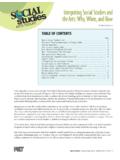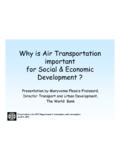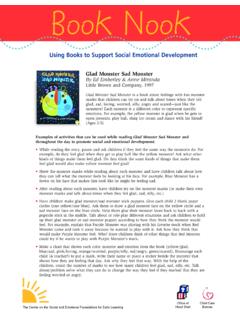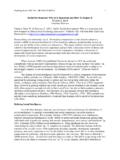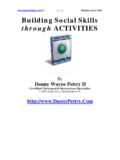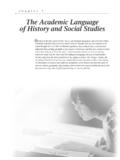Transcription of Integrating Social Studies and the Arts: Why, When, and How
1 Social Studies Integrating Social Studies & the Arts 1 TABLE OF CONTENTSI ntegrating Social Studies and the Arts: Why, When, and HowBy Judy SizemoreArts integration is not a new concept. Even before Harvard researcher Howard Gardiner revolutionized the way we theorize about learning and intelligence with his theory of multiple intelligences, teachers knew that they had to differentiate their instruction in order to address the diverse learning styles of students in their classrooms. Brain research indicates that learning, whether the retention of factual information or the development of critical and creative thinking skills, is enhanced by rich context and multisensory instruction. Integrating arts into the Social Studies curriculum is an excellent way to allow students with diverse learning modalities to become more effective learners, but it can actually accomplish much more than that.
2 The arts reflect the unique cultural perspectives of diverse cultures and illuminate migration patterns and cultural interactions. Because artists respond to and impact the societies in which they live and create, the arts provide a window into other times and places. Learning about diverse cultures through their arts can help to explode stereotypes. The arts are a critical component of Social Studies in addition to being an effective way to teach. At the same time, cultural and historical aspects of Social Studies are also components of the Arts and Humanities Program of Studies and would provide a depth of cultural context that would enrich the learning in the arts. But while many teachers know that their students would benefit from an integrated approach, achieving it is per-haps more challenging than ever. Teachers who are overwhelmed by the breadth of material that they must cover within a semester are often hesitant to try to add one more thing to an already jam-packed curriculum.
3 PageStart with Your Comfort Level .. 2 Why Now? The i-Generation and 21st Century Skills .. 2 Arts Are Interactive .. 321st Century Learning Skills .. 3 New Directions in Kentucky Education .. 4 Team Teaching and Other Strategies .. 5 The Importance of Resources .. 5 What Does an Integrated Lesson Look Like? .. 6 Aligned Content .. 7A Closer Look: Sample Lesson Outlines .. 7 Social Studes and Craft Traditions .. 7 Sample Lesson: Introduction to Basket Making Traditions .. 9 Sample Lesson: Native American Pottery Traditions .. 11 Sample Lesson: Crafts and Economics .. 14 Berea s Storied Past .. 15 Craft and Economics: Classroom Business-Production of Ornaments .. 16 Resource Guide .. 18 ARTS TOOLKIT 2 Integrating Social Studies & the Arts Social Studies START WITH YOUR COMFORT LEVELThis is not to say that you have to revamp your entire curriculum in order to add arts to the Social Studies classroom or Social Studies to the arts classroom.
4 You can begin with one or two activities, and you can begin at various levels of integration. Start where you are comfortable and expand slowly. Partner with another teacher or bring in an outside expert like an artist in residence or a cultural speaker. Utilize high-quality multimedia resources like that found in the Social Studies Arts Toolkit prototype. And document what you do. This will help you track your own professional growth, and it will provide the documentation that your school will need for the Program Review in Arts and Humanities. WHY NOW? THE I-GENERATION AND 21ST CENTURY SKILLSThe benefits of interdisciplinary education have been well documented. Not only does it appeal to students with diverse learning styles, but it also allows students to make connections among the different branches of learning and to rein-force their understanding and knowledge.
5 The need for integrated instruction is more compelling than ever for two reasons: the way that students think and pro-cess information is changing, and the world for which we are preparing them is s students are sometimes referred to as the i-Generation, the net generation, or digital natives. They have never experienced a world in which people could not be constantly connected by cell phones, in which information was not instantly accessible through mobile devices, or in which Social networking did not refer to electronic media. They expect to be able to individually customize everything from the ring tones of their cell phones to the parameters of their internet research. Even students whose home environments are not technology oriented, whether due to financial con-straints or conscious choice, are maturing as part of a techno-driven, inter-related often complain that students have very short attention spans, and just want to be entertained.
6 Some Studies suggest that the attention span of an average elementary student is as short as nine seconds. Does this mean that teach-ers need to provide new stimuli every nine seconds in order to compete with Wii stations for their students attention? Certainly not. But it does mean that teachers need to be aware of how their students life experiences impact the learn-ing his book, Rewired: Understanding the iGeneration and the Way They Learn, psychology professor Larry D. Rosen identifies distinctive iGeneration traits, including: Early and continuous exposure to technology; Desire for immediate gratification; Expectation of innovation; Ability to use media; and Adeptness at multitaskingClearly not every child today shares these traits, and just as clearly there are more influences on today s youth than im-mersion in technology.
7 But these traits are pervasive enough that it s important to consider them when creating lesson plans and units of study. Students are bored by instruction that focuses on a single task through lecturing or repetition. They are interactive rather than receptive learners. They want to be engaged in their learning or they will tune Studies Integrating Social Studies & the Arts 3 ARTS ARE INTERACTIVEW hile incorporating technology into instruction is one way to engage i-Generation learners, it is not the only way, and it is not always the best. Creating and performing in the arts is highly interactive, student-centered learning that can help to balance an over-dependence on (or downright obsession with) the outside stimulus provided by technology. Students can expand their concentration and focusing skills beyond a desire for instant gratification as they learn to in-teract with the structures and materials of diverse art forms and cultural styles.
8 They can learn to use actual 3-D media as well as how to manipulate icons on a computer screen, thus developing their kinesthetic intelligence and problem solving ability. They can learn to collaborate with real people rather than interacting with virtual entities over which they have ultimate control, thus strengthening their interpersonal intelligence and developing civic literacy. They can learn to be the generators of innovation rather than expecting the world to generate innovation to satisfy their every whim. They can learn to express their own thoughts and ideas in a variety of ways and to develop the critical thinking skills that will enable them to evaluate and analyze the barrage of information streaming into their consciousness from the abundance of technology in their environment. Integrating content from arts and Social Studies , with or without technology components, will empower students to make constructive use of their adeptness at multi-tasking and become active rather than receptive users of technology.
9 21ST CENTURY LEARNING SKILLSArts infused instruction not only engages i-Generation learners, but also helps to prepare them for a world that is in a state of accelerating change in terms of technology and economics and Social , political, and environmental challenges. In the 20th century, most jobs involved doing the same thing every day with each worker doing a separate part of the job alone. But today s classrooms must prepare students for a future in which collaboration and interdisciplinary work are the Partnership for 21st Century Skills advocates for the integration of 21st century skills and 21st century interdis-ciplinary themes into core subjects. They identify the essential interdisciplinary themes as: Global awareness; Financial, economic, business, and entrepreneurial literacy; Civic literacy; Health literacy.
10 And Environmental identify 21st century skills as: Critical Thinking and Problem Solving Communication Collaboration Creativity Innovation Information Literacy Media Literacy Information, Communication, and Technology Literacy Flexibility and Adaptability 4 Integrating Social Studies & the Arts Social Studies Initiative and Self-Direction Social and Cross-Cultural Skills Productivity and Accountability Leadership and ResponsibilityThe Kentucky Department of Education recognizes the importance of including 21st century interdisciplinary themes and developing 21st century skills in students. The KDE has provided school administrators with resources to enable them to integrate 21st century themes and skills into the overall school program beginning in is little wonder that teachers feel overwhelmed by the demands made on them.
